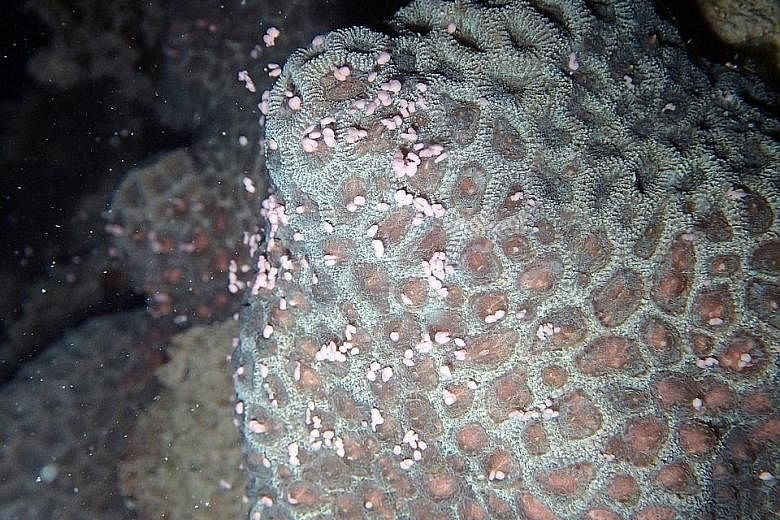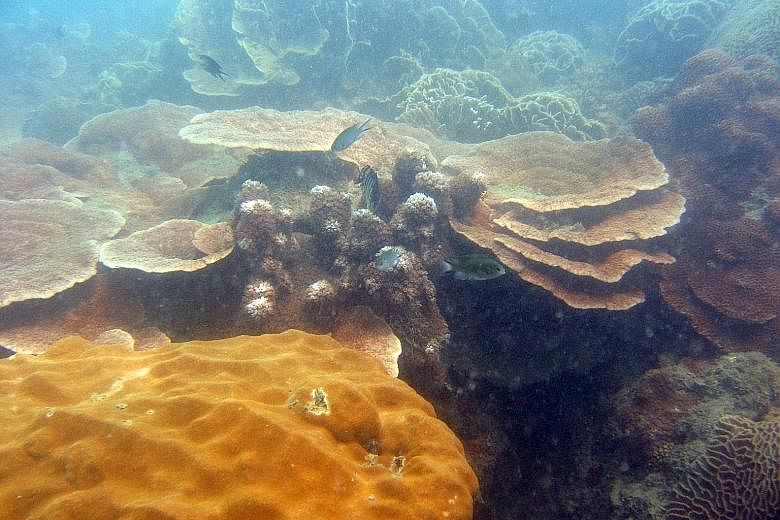Ocean health is human health.
The oceans cover 70 per cent of the earth's surface - producing more than half the oxygen we breathe, yielding most of the fish people eat - and their depths may hold many cures for human ailments that have yet to be uncovered.
Under these waters lie coral reefs that occupy a mere 0.2 per cent of ocean beds, yet support about 25 per cent of the world's marine life.
Some 255 species of hard corals, making up about a third of the global coral diversity, can be found in Singapore.
Beneath our coastal waters are urban reefs, which are home to a myriad of marine life - sharks, dolphins, sea turtles, as well as benthic denizens such as the Neptune's cup sponge and giant clams - in one of the world's busiest shipping ports.
As Singapore is an island state, coral reefs also form an integral part of our seascape and are emblems of our national heritage.
In Singapore's quest to be a global maritime hub, it is important to safeguard the health of our coral reefs - and the marine environment as a whole - so that we will continue to reap the benefits of the ecosystem services they provide.
In addition, we can achieve greater resource resilience - such as with food from mariculture and water from desalination - and be seen as a smart and eco-conscious nation.
CORAL RESEARCH DURING COVID-19
When circuit breaker measures kicked in on April 7, marine scientists who usually work on coral reef monitoring and conservation were landlocked and had to look for ways to make the most of the situation.
As seasoned marine ecologists, we are trained to deal with surprising and unexpected events - such as bad weather and vessel engine troubles while out at sea. Yet nothing could have prepared us for a pandemic on the scale of Covid-19.
Local marine scientists are heavily dependent on facilities at the St John's Island National Marine Laboratory (SJINML), which is managed by the National University of Singapore (NUS), to maintain the live cultures of marine organisms used for research and conservation.
Like babies, these marine organisms need regular care and attention for their survival. For example, small fragments of corals grown in the aquaria for conservation work need to be regularly "cleaned" to prevent algae from smothering them.
In the field, each year, usually around March and April, corals spawn their eggs and sperm into the water in one of the most spectacular events in nature that sees the reefs come alive to celebrate the abundance of new life.
With no access to coral reefs this year, marine scientists were unable to monitor the intensity of coral spawning, missing out on the collection of important data that could help scientists predict the future of our reefs.
This pandemic has propelled the urgency to harness technology to continue research, to monitor coral reefs and to engage people.
For example, scientists from the Tropical Marine Science Institute at NUS have recently been deploying underwater acoustic recorders and developing different machine learning algorithms to automatically detect reef noises that could be used to monitor the health of coral reefs.
This work is part of a project under the National Research Foundation's Marine Science Research and Development Programme.
THE NEW NORMAL
With Covid-19 heralding a new norm, there will be greater demands to leverage technologies to observe and learn from the oceans and their creatures.
Currently, there is no national system to carry out real-time monitoring of our marine environment for research purposes near sensitive marine ecosystems such as those around our Southern Islands.
For marine scientists, access to such remote observation capabilities will become increasingly crucial. The pandemic will (hopefully) subside in time to come, but the challenges faced by the oceans will remain and the messages of conservation need to be heard.
Covid-19 has opened our eyes to the fact that technologies can also be used to engage the public. As learning goes virtual, the SJINML, for example, is now using teleconferencing tools and social media platforms to keep audiences up to date with marine science.
WORLD OCEANS DAY 2020
World Oceans Day is observed annually on June 8 to celebrate the health and wealth of the oceans that contribute to our own survival.
In Singapore, marine scientists and volunteers often join in the festivities to communicate science and do good for the reefs, such as by organising underwater clean-ups.
The significance behind these activities is: to stand in solidarity, to call for action on ocean issues and to pledge our commitment in adopting a more sustainable lifestyle.
This year's World Oceans Day will be unlike any other year, as it will take more effort to unite ocean action virtually.
While we hope that the pandemic will ease and allow us to return to the waters to continue research and conservation efforts, we need to embrace technology to lend us a hand in looking after our coral reefs.
• Dr Neo Mei Lin is a research fellow at the Tropical Marine Science Institute, National University of Singapore (NUS), and one of the resident scientists working at the St John's Island National Marine Laboratory (SJINML).
• Dr Jani Tanzil is a senior research fellow at the Tropical Marine Science Institute, NUS, as well as the deputy facility director at SJINML.




